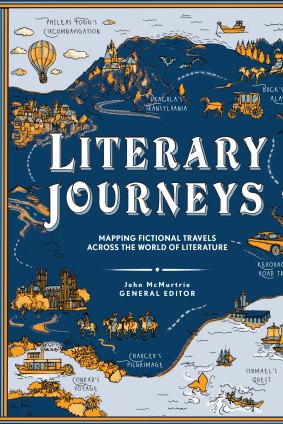
“Now when I was a little chap I had a passion for maps,” says Marlow in Joseph Conrad’s novel Heart of Darkness. When he saw a promising blank space, “I would put my finger on it and say, When I grow up I will go there.”

That’s the spirit that drives more than 75 works of fiction featured in Literary Journeys, another splendidly illustrated book from the stable that gave us Literary Landscapes. Each work gets an overview from one of a team of 55 academics, critics and authors.
We begin with Homer’s Odyssey and end with Amor Towles’ 2021 novel The Lincoln Highway, and there’s all manner of tales in between; the only criteria editor John McMurtrie imposes are that the journey must be a work of literary fiction based on real places, and it has to act as both a travel companion and a time machine. The heroes travel on foot, on horseback, on bicycles, by balloon, car, train and boat.
Most of the classics you’d expect to find are here (Herman Melville’s Moby Dick, Geoffrey Chaucer’s The Canterbury Tales, John Steinbeck’s The Grapes of Wrath, Mark Twain’s The Adventures of Huckleberry Finn and so on).
But part of the pleasure for me was discovering tales I’d never heard of, or tales I knew very little about. Now, for example, I want to read Mexican novelist Yuri Herrera’s 2009 novel Signs Preceding the End of the World. It starts with a giant sinkhole and crosses the border from Mexico into the US on a rubber raft, with echoes of journeys in the Aztec underworld.
Two Australian authors get a look-in: Patrick White with Voss, his 1957 odyssey in the steps of explorer Ludwig Leichhardt into the outback, and Tim Winton’s Dirt Music, in which his hero Lu drives north “to the heartless heart of nature” in a quest to discover an island wilderness. (Australian resident J. M. Coetzee is here too with his novel Life & Times of Michael K, set entirely in South Africa.)
Many of these works have a familiar theme: a young man sets out on a journey with high ambition, maybe scorning or escaping his origins, always searching for something elusive about life, so the outer journey is mirrored by an inner journey. We see that story repeated in tales such as Jack Kerouac’s On The Road, Wolfgang Herrndorf’s Why We Took the Car, or Halldor Laxness’s The Great Weaver from Kashmir. Women play a minor role: they are either the sweetheart left behind or the sexy girls met along the way (or in one brilliantly creepy version, the abused child in Vladimir Nabokov’s Lolita).

Follow the routes travelled by famous authors without leaving home.Credit: iStock
As we move further into the 20th century, the tales widen out. Many tell stories of refugees or migrants forced to leave their homes. The narrators and their creators are more likely to be women or people of colour. They might not even be human: Arikawa Hiro’s 2012 novel The Travelling Cat Chronicles follows street-smart stray cat Nana as he and his human friend Satoru explore Japan in a silver van.









 Add Category
Add Category